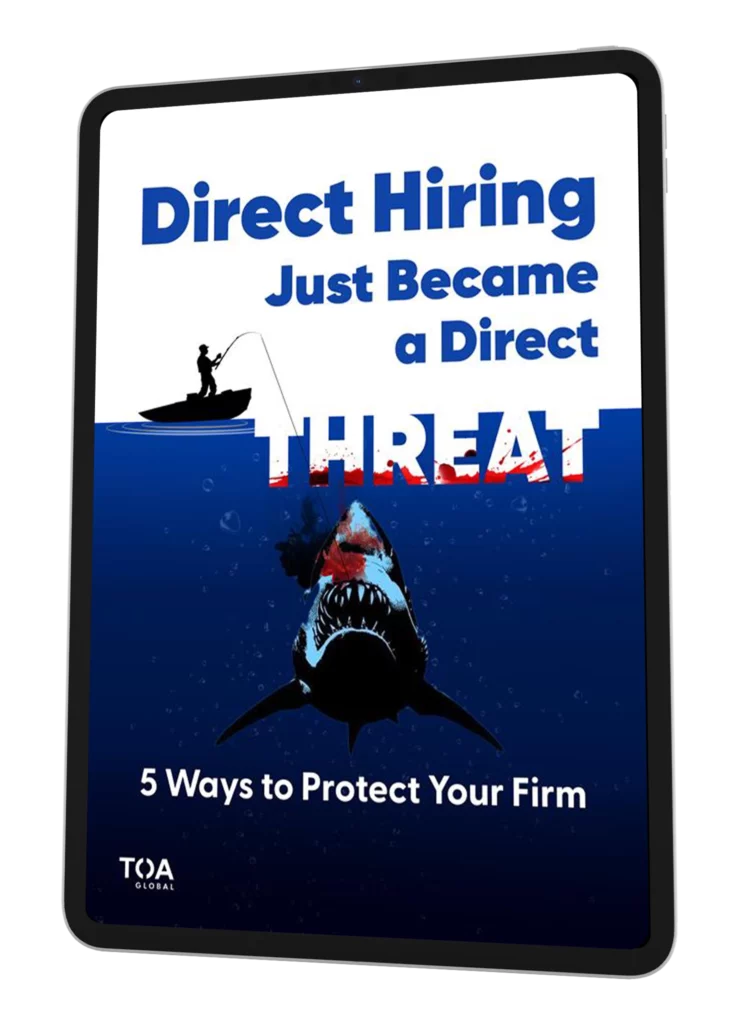Many accountants now realise that “back office outsourcing” isn’t a passing fad. It’s a way for accounting firms to deliver more value at lower cost, while preserving margins and continuing to develop and reward great people.
In this article, we explore which offshore roles to hire first so you can you can start and grow your team through a series of low-risk steps.
Firms that execute these steps in the right order find themselves on the Success Cycle, where they develop greater and greater levels of confidence and capability.
Conversely, firms that make a few early errors tend to experience the frustration and discouragement associated with the Failure Cycle.
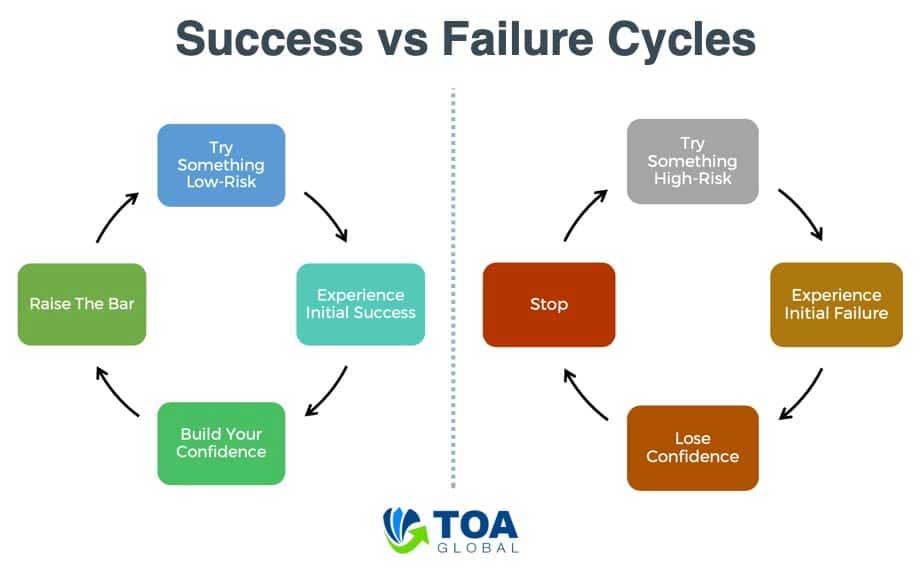
So let’s break down the right steps in the right sequence…
You Want To Leverage Your Best People, Not Replace Them

Accounting firm owners who are struggling to find good talent sometimes start by saying…
“I can’t find a senior accountant locally, so I’ll try to hire a senior accountant offshore.”
Others may have heard about the concept of offshore outsourcing, but they simply can’t get their head around how they might source the talent they need:
“It’s hard enough to find great talent in my local area. How is someone in a different country going to plan the tax strategy for one of my sophisticated clients?”.
We would suggest that these questions are the wrong questions to ask. A better question might be:
“How can we leverage the time, skills and abilities of our current team to deliver more value to clients at higher margins?”
Once you look at the question this way, you can frame the problem in terms of leveraging your current team rather than duplicating (or replacing) them.
The Productivity Crisis Facing Most Accounting Firms

Most accounting firms struggle to generate more than 2.5X an accountant’s salary in fees. In other words, a $100,000 p.a. employee may be stretched to bill $250,000 annually.
Once you account for holidays, sick days, professional development and training, there are only around 1,600 work hours in a year.
Then add in meetings, admin and other “busywork”, and another 400 hours get lost. This leaves just 1,200 hours to bill.
At the same time, you have clients who are demanding more and more value for the same or less fees.
The result is a pressure cooker situation where you can struggle to deliver the output you need at the fees you need to charge and at a price clients are willing to pay!
The solution is to start by taking the easiest and most process-driven tasks of the plate of your local team members and build from there.
We call this progression the 5 Phases of Outsourcing Success.
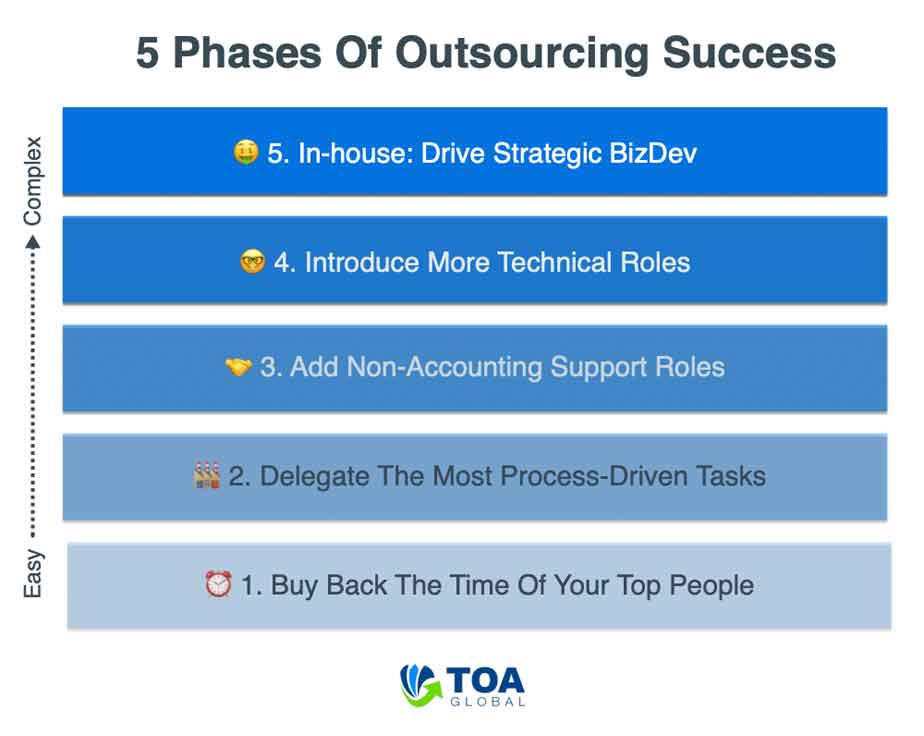
The 5 Phases represent a staged approach to introducing outsourcing into your firm. While you don’t have to implement them in the exact order shown, our experience suggests that those firms who do enjoy better results.
1. Buy Back The Time Of Your Top People
Most accountants are delivering a mix of high, medium and low-value activities. A brilliant tax strategy may be worth $1,000 per hour (or more), but there is only so much you can charge for a monthly P&L report.
So step 1 is to “buy back the time of your top people” by taking some of the low value work off their plate. You can do this by hiring an Executive Assistant to support your key people.
2. Delegate The Most Process-Driven Tasks
Rather than starting with the most technical and difficult tasks, we recommend delegating the relatively easy, process-driven work first.
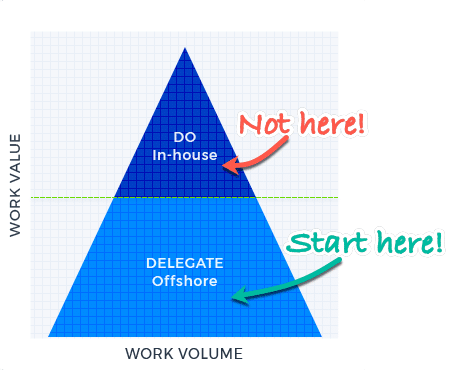
In order to do this well, you need to ensure you have robust systems and processes in place (or, you can get your new hires to map out your processes as they go).
3. Add Non-Accounting Support Roles
As you grow the capacity of your team, you may notice a growing need for more supporting roles. Or, there may be functions that your in-house team used to perform (such as project management or client co-ordination) that they no longer have time for.
During this Phase, many firms bring in specialized roles to fill this gap. If you want to know what type of functions can be covered, here are 11 Non-Accounting Roles That Accounting Teams Are Hiring Offshore.
4. Introduce More Technical Roles
Only once you have your systems locked down and are delivering a range of process-driven tasks for clients, should you consider hiring more senior and technical accounting roles offshore.
What you’re gradually doing is “moving the line North” as you gradually ratchet up the leverage your onshore team enjoys.
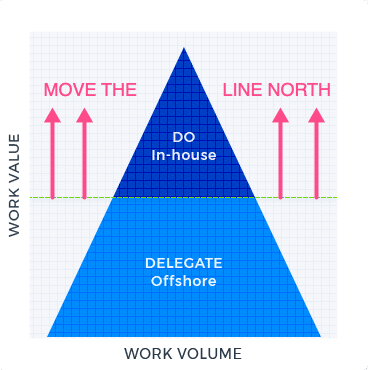
Note that the impact of your onshore team is not reduced. There is no limit to the amount of value your onshore team can add, especially as you move into the next Phase…
5. In-House: Drive Strategic Business Development
Once you have a production machine that can deliver large volumes of low- and medium-complexity work, your in-house team can get out there and sell advisory and strategic value.
This means engaging in high-value conversations with clients to deliver even more creative and impactful solutions to their business challenges.
Many accountants lament the fact that they can’t engage in enough of this type of work because they’re too bogged down in the trenches. If you follow the 5 Phase framework we’ve just covered, you’ll be freed up to add the value you know you’re capable of adding.
3 Bonus Tips For Accelerating Outsourcing Success

The 5 Phase model will help you dial in the right sequencing for building a “two-office” delivery model. Now here are 3 more tips for accelerating your progress:
- Hire (at least) 2 full time resources from the start: some firms want to “get their feet wet” with outsourcing and hire only one resource initially. While this sounds low-risk, one resource requires almost the same amount of structure, training and supervision as two or more offshore staff. Given that you will have to devote internal resources to training your new staff, it makes sense to start with more than one offshore staff member so you can maximize the value of your time.
- Systems, Systems, Systems: locking down your processes into flowcharts, with instructions and checklists, is the best way to guarantee high-quality output. You can even ask your new offshore talent to record their work (and your feedback) as they go. Pretty soon, you’ll have workable systems in place.
- Treat your offshore staff as a full team member. Your new staff are much more than “outsourced help” – they’re an integral part of your team. Firms who treat their offshore team accordingly and invest in training and development tend to reap the best rewards.
Conclusion And Next Steps
Just like baking a cake, building an offshore team requires not just the right “ingredients” but the right ingredients in the right order.
By using the 5 Phases model, you’ll be following in the footsteps of our most successful clients who have built a profitable and sustainable “second office” with TOA Global.
To take the next step, get in touch to arrange a Free Outsourcing Strategy & Plan for your firm. We’ll work with you to understand your situation and objectives, then map out a staged plan for hiring the talent you need in the right order so you can grow your capacity and margins.














